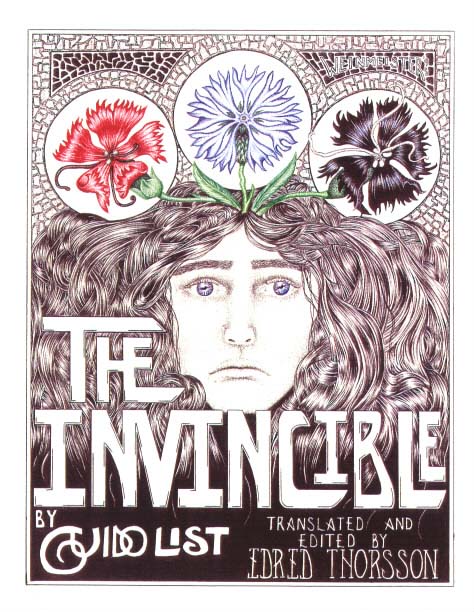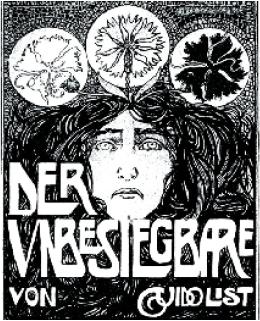The Invincible ( Der Unbesiegbare) 1892
by Guido von List
This new English translation is a beautifu l facsimile edition of the 1898 "Germanic catechismô by the man who would later become the leader of an esoteric Germanic revival just a few shor  t years later. This edition is a virtual replica of the original with all the art-nouveau style art-work redrawn and beautifully illustrated closely following the original b y Timothy Weinmeister. The text is an outline of a moral teaching with which few could disagree. Translation is by Edred Thorsson / Stephen Flowers, Phd .
t years later. This edition is a virtual replica of the original with all the art-nouveau style art-work redrawn and beautifully illustrated closely following the original b y Timothy Weinmeister. The text is an outline of a moral teaching with which few could disagree. Translation is by Edred Thorsson / Stephen Flowers, Phd .
About "The Invincible" by Irminenschaft : "this work, which first appeared in 1898, is a historical landmark in the evolution of Germanic religious philosophy, marking a pivotal point in the Altmeister's own self-initiation.. one that would later give rise to the rebirth of the Germanic Heathen dynamic in full form! Christian philosophical influences are of course apparent in this early work, though for today's Germanic Heathen, it remains quite an insightful and illuminating work on many key levels!"
About "The Invincible" from "The Secret of the Runes" by Guido von List (English translation):
"The time between the publication of Der Unbesiegbare (1892) [The Invincible], List's neo-Germanic catechism, and the year 1902 marked a period of transformation of List from someone known primarily as an artist to an occult investigator, religious leader, and prophet of a coming age.
Concerning the generationm of the manuscript for Der Unbesiegbare there is a story that perhaps demonstrates the growing-ifambivilent-association between mysticism and politics in these circles. In the summer of 1898, a law prescribing religious instruction in Lower Austrian secondary schools was being debated. Dr. Karl Lueger, who was later to become the mayor of Vienna and a member of the Guido von List Society, was for the bill, as were church officials. When he was questioned on this by representative Karl Wolf, Lueger responded: "Gebt uns Besseres und wir werden Euch folgen!" (Give us something better and we shall follow y ou!). It is said that List was deeply moved by this and wrote Der Unbesiegbare overnight. List took the manuscript to Wolf's office the next day, but the whole idea was eventually rejected by Wolf, as his interests in religion were "just matter of curriculum." The catechism was printed in an edition of five thousand copies, marking the beginbning of List's more practical religious career. "
 Th e following p asdsage was written by Johannes Balzli in his 1917 biography of Guido von List:
Th e following p asdsage was written by Johannes Balzli in his 1917 biography of Guido von List:
"... The Invincible, an Outline of Germanic Philosophy appeared in 1898. The Invincible is a kind of catechism. The story of the origin of this little book is worth recounting. In the summer of 1898 the state government of Lower Austria passed a law that mandated religious instruction for middle-school (gymnasium) pupils. The cardinal and Arch-Bishop of Vienna (Dr. Gruschen) spoke up fo rthe law as did the state marshall Prince Alois Liechtenstein and the eventual mayer of Vienna, Dr. Karl Lueger. Subsequently in a council of voters of the 6th district of Vienna representative K.H. Wolf requested an official opinion from Dr. Lueger concerning the law. Dr. Lueger answered "Give us something better and we will follow you!" Guido von List was deeply effected by all this. Overnight, that is from one day to the next, he wrote down his catechism "The Invincible," without sleeping, on the next day he went to visit representative Wolf and delivered the finished manuscript to him with the words: "So, there you have something better!" But Wolf rejected the idea right away, because for him "Religion was only an acedemic thing." Even if nothing was to be gained this way = "The Invincible" was nevertheless printed and soon 5000 copies had been sold. Even if today "The Invincible" is, as the Master himself says, "antiquated," because it has been "superseded by much deeper knowledge," nevertheless back then it was a beginning. The Invincible is therefore in a certain sense a historical marker, and it was no exageration when during a conversation in the Master's apartment on the 6th of January 1898 the old Catholic bishop Nittel von Warnsdorf in German Bohemia said that from Guido von List's desk "a new epoch in the history of religion will go forth!"
The artwork for this volume was created by Timothy Weinmeister, closely based on the art of O.C. Czesnko which accompanied the 1898 edition of Der Unbesiegbare. Weinmeister meticulously creates his remarkable works using only ballpoint pens. His also represents the second generation in his family to study the works of Guido von List.
MORE COMING SOON...
To purchase "The Invincibles" check out the links below:
Europa
or
Runa Raven Press of the Rune Gild
 t years later. This edition is a virtual replica of the original with all the art-nouveau style art-work redrawn and beautifully illustrated closely following the original b y Timothy Weinmeister. The text is an outline of a moral teaching with which few could disagree. Translation is by Edred Thorsson / Stephen Flowers, Phd .
t years later. This edition is a virtual replica of the original with all the art-nouveau style art-work redrawn and beautifully illustrated closely following the original b y Timothy Weinmeister. The text is an outline of a moral teaching with which few could disagree. Translation is by Edred Thorsson / Stephen Flowers, Phd .